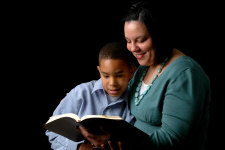How to Teach Your Kids to Read
The Wonder of Reading
 To
teach your kids to read is one of the greatest investments you can personally
get involved in. Reading opens countless opportunities to learn new things and
expand perspectives. Understanding how words are formed and being able to
recognize them are perhaps one of the most important milestones in a child’s
life. To read comfortably before going to school is a necessity for kids these
days. For some, it comes quite quick but for others, it can be quite
challenging. It is important for parents to help and encourage children to
develop a love for words early on. To
teach your kids to read is one of the greatest investments you can personally
get involved in. Reading opens countless opportunities to learn new things and
expand perspectives. Understanding how words are formed and being able to
recognize them are perhaps one of the most important milestones in a child’s
life. To read comfortably before going to school is a necessity for kids these
days. For some, it comes quite quick but for others, it can be quite
challenging. It is important for parents to help and encourage children to
develop a love for words early on.
With correct strategies and patience, young children learn to read almost
effortlessly. As babies have more flexible brains for learning, exposing them to
the beauty of words as early as three months creates potential for producing an
excellent reader in the future. With almost all subjects requiring reading,
teaching your kids to read means preparing for the more complicated school work
ahead. Devoting a couple of minutes for a reading session, when repeated over a
certain period of time, it enables kids to remember the words quicker than we
actually think they can.

The Perfect Period
The increasing number of parents interested in teaching their kids how to read
is a good sign that we are starting to develop a culture that produces excellent
readers. Before kids reach the age are more likely to move around incessantly,
their hunger for knowledge and understanding of the world can help parents mold
them easily into bookworms and active learners. It is also essential for parents
to understand that they should not expect the child to learn reading right away.
A child's learning style and pace vary, so be sure the level of reading you want
your child to achieve fits their degree of readiness.
 Despite
the benefits brought on by early reading, many parents might argue that doing so
equates to removing some joy from a child's earlier life This might be true as
many would mistakenly consider reading to their children as teaching, when both
are actually different. Many fail to recognize that when they read to their kid,
they are inculcating the love for reading and not forcing their child to
memorize information. What makes the love for reading kick off is the exposure
to great stories delivered by written words. Despite
the benefits brought on by early reading, many parents might argue that doing so
equates to removing some joy from a child's earlier life This might be true as
many would mistakenly consider reading to their children as teaching, when both
are actually different. Many fail to recognize that when they read to their kid,
they are inculcating the love for reading and not forcing their child to
memorize information. What makes the love for reading kick off is the exposure
to great stories delivered by written words.
Raising a Reader
As parents, teachers and loved ones, we all want to raise children who are
confident and competent in reading. However, in most cases, we are quite unsure
what to do. Worst, some parents even end up pushing their children too hard.
Because children learn very different from each other given their different
circumstances, here are some general guidelines to help raise a reader.
-
 Read
to your kids early. As many of us have learned, learning starts even
before the child sees the world the first time. This simply means that even
in infancy, the child has the capacity to acquire information. As early as
the days you settled your child into her/his bedroom, start finding time to
do some reading. This does not only expose the infant to the spoken words
but also instills
love
for written words. If a child does not exhibit any interest
for reading, school work will be challenging during the years to come.
Consequently, this means they would fail to suffice the necessary elements
for a successful academic preparation and for life as professionals. Read
to your kids early. As many of us have learned, learning starts even
before the child sees the world the first time. This simply means that even
in infancy, the child has the capacity to acquire information. As early as
the days you settled your child into her/his bedroom, start finding time to
do some reading. This does not only expose the infant to the spoken words
but also instills
love
for written words. If a child does not exhibit any interest
for reading, school work will be challenging during the years to come.
Consequently, this means they would fail to suffice the necessary elements
for a successful academic preparation and for life as professionals.
- Make reading a daily habit. When the child is familiar with books
and the way words are written to produce a certain sound, he is on a head
start to discovering knowledge embedded into the intertwining words in the
books. As you initiate your daily reading, the child gets the picture of
reading, being important to you and thus to him as well. This will more
likely influence your child to read the way you modeled it. To make it even
more effective for recognizing words, move your fingers across the page as
you read. Point on the words as you go along, so the child gets the image of
the words being read aloud. Remember, many children learn and retain
information when visual representation is present.
- Begin with the basics. As with many things, it is important to
begin with the basics. When reading to the child, don’t just pick any book
you may find in the bookstore. Instead, take into consideration the child’s
age, interest and level of understanding. When they are too young enough,
begin with lullabies, board books, book of rhymes and story books. Story
time is also one of the best ways to teach reading. Read in such a way that
your child could grasp the concepts of reading and the joy it brings to
one’s imagination. The use of varying tones of voices in reading makes the
child imagine the story and its characters vividly. This in turn would spark
interest in learning to read independently. If you are in need of some
quick teaching material for your child, I recommend picking up a copy of rainbow games, you can print their reading games and start teaching your
child immediately.
-
 Make
reading sessions interactive. The main reason for reading to the child
early is to get the mental picture of how words are put together and
uttered. Do not end there. Being able to recognize words and phrases and
reading them correctly isn’t enough. The child must understand what was
read. Make reading sessions an avenue for developing reading fluency with
comprehension. As we read, we can facilitate comprehension by asking
questions. When children are very young, you can begin developing
comprehension by asking questions like, “Do you see the dog?” while pointing
on the portion of the picture book with the dog. Doing so will increase
vocabulary and ability to make associations. When the child is more
advanced, ask questions like “Why did the king give the old man an apple?”
to confirm the child’s ability to recall information. When the child can
interact with the text, reading will be a pleasure. Make
reading sessions interactive. The main reason for reading to the child
early is to get the mental picture of how words are put together and
uttered. Do not end there. Being able to recognize words and phrases and
reading them correctly isn’t enough. The child must understand what was
read. Make reading sessions an avenue for developing reading fluency with
comprehension. As we read, we can facilitate comprehension by asking
questions. When children are very young, you can begin developing
comprehension by asking questions like, “Do you see the dog?” while pointing
on the portion of the picture book with the dog. Doing so will increase
vocabulary and ability to make associations. When the child is more
advanced, ask questions like “Why did the king give the old man an apple?”
to confirm the child’s ability to recall information. When the child can
interact with the text, reading will be a pleasure.
- Listen as your child reads. As the reading to your child
progresses from lullabies to picture books to story books, begin to teach
your child the alphabet and the sound of the letters. The sound of the
letters is as important as the letters themselves because the child will put
them together and combine the sound they make individually. After a while,
you can start introducing simple combinations of consonants and vowels.
Beginners are known to do well when reading this simple combination. You may
be surprised how excited the child can be in decoding the combinations. When
ready to read simple words, give the child the opportunity to read aloud
while you listen. Provide help when they find some words difficult. You can
even model reading the entire sentence and make the child repeat until there
are minimal mistakes. Don’t forget to
give praises when the child reads correctly as this will make
reading something to look forward to.
 Summing
Up Summing
Up
For those who were born lucky with the gift of language, learning to read is
easy. It seems to come naturally with less intervention. For many others, it has
to be introduced early on. There is no other way to ensure the kids’ love
reading than doing our part. Beginning from younger age when the brain is
flexible enough to adapt, curious enough to learn and discover and easy enough
to mold, reading should already become part of life. As a milestone and a start
point towards a more enjoyable and successful academic life, this should be
inculcated and developed for the child to reach the highest possible potentials.
Remarkably, reading does not only develop the cognitive skills but makes
children feel the parents’ involvement on their lives.
Learning
How to Overcome Test Anxiety
15 Incredible Yet Weird Story Lessons About Wisdom
Myths and Realities on Bilingualism
The Benefits of Being Bilingual
Learning Disabilities: Types and Signs
The Role of Listening in Language Learning
Helping Your Child Develop a Love for Writing
How to Teach Your Kids to Read
The Influence of Music on Children’s Learning
Teachers
5 Reasons to Use Norm Referenced Tests in the Classroom
5 Ways to Use Criterion Referenced Test in the Classroom
Photo Memoir: Writing Assignment
Top 5 Things to Know About Your ESL Students’ Backgrounds
Group Work in College ESL Classrooms
How to Teach Business English in ESL Setting
Benefits of Using Graphic Organizers in the Classroom
How to Use Storytelling in Language Teaching
How to Correct Student Essays
The Most Common Problems in ESL Classrooms
Tips on Teaching ESL Students Vocabulary
Praise: A Great Motivator for Student Achievement
Peer Feedback is a Great Tool in Writing Classes
 |